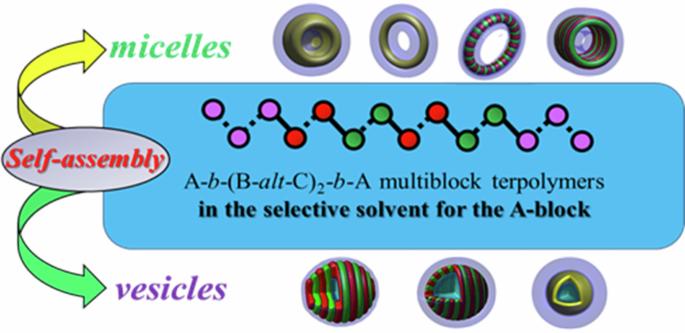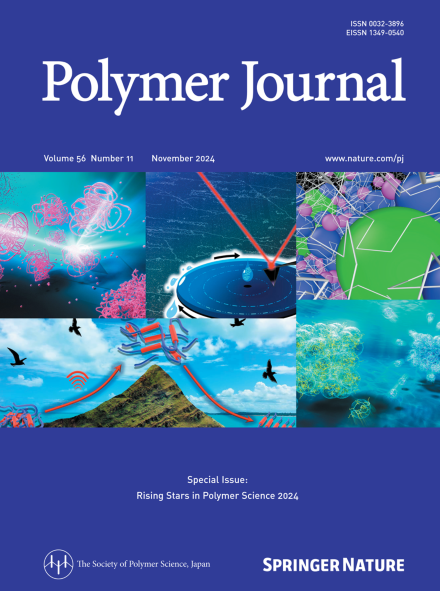Discovering the micellization of linear A-b-(B-alt-C)2-b-A multiblock terpolymers in selective solvents
IF 2.7
4区 化学
Q3 POLYMER SCIENCE
引用次数: 0
Abstract
The self-assembly of ABC amphiphilic multiblock terpolymers into multicompartment micelles in dilute solutions has gained significant attention. In this study, we employed the three-dimensional (3D) self-consistent field theory (SCFT) method to explore the micellization behavior of amphiphilic linear A-b-(B-alt-C)₂-b-A multiblock terpolymers in a solvent selective for the terminal A block. A variety of intriguing micellar structures were identified, including B- and C-disk segmented vesicles, B- and C-toroidal packing within a tubular structure, BC-segmented toroidal micelles, infinite BC-segmented cylindrical micelles, and BC-mixed toroidal micelles. Owing to the connection of blocks B and C with block A, the segmented arrangement of layers B and C follows the axial direction of the structures. As the volume fraction of the A block (fA) decreases, a structural transition from vesicles to micelles occurs in the linear A-b-(B-alt-C)₂-b-A system, in contrast with the behavior of A(BC)n multiblock terpolymers, which transition from micelles to vesicles. The SCFT method has proven to be an effective tool for identifying molecular architectures with the potential to self-assemble into complex, technologically valuable hierarchical structures. This study systematically explored the micellization of A-b-(B-alt-C)₂-b-A multiblock terpolymers using SCFT, revealing how block composition, interaction strength, and solvent selectivity govern diverse morphologies—including segmented vesicles, toroids, and cylinders. Symmetric and asymmetric solvent conditions yielded distinct BC-segmented structures, while poor solvent conditions led to hierarchical transitions. These insights offer design principles for functional materials like drug carriers by enabling precise control over self-assembled nanostructures.

发现线性A-b-(B-alt-C)2-b-A多嵌段三元聚合物在选择性溶剂中的胶束作用
ABC两亲性多嵌段三元聚合物在稀溶液中自组装成多室胶束的研究引起了人们的广泛关注。在本研究中,我们采用三维自洽场理论(SCFT)方法研究了两亲线性a -b-(B-alt-C) 2 -b- a多嵌段三元共聚物在末端a嵌段选择性溶剂中的胶束行为。发现了多种有趣的胶束结构,包括B盘和c盘分段囊泡,管状结构内的B和c环形堆积,bc分段环形胶束,无限bc分段圆柱形胶束和bc混合环形胶束。由于B、C块与A块的连接,B、C层的分段排列遵循结构的轴向。随着A嵌段(fA)体积分数的降低,线性A-b-(B-alt-C) 2 -b-A体系发生了从囊泡到胶束的结构转变,而A(BC)n多嵌段三元聚合物则从胶束转变为囊泡。SCFT方法已被证明是识别具有自组装成复杂的、技术上有价值的分层结构潜力的分子结构的有效工具。本研究利用SCFT系统地探索了A-b-(B-alt-C) 2 -b- a多嵌段三元聚合物的胶束化,揭示了嵌段组成、相互作用强度和溶剂选择性如何控制不同的形态,包括分段囊泡、环状体和圆柱体。对称和不对称溶剂条件产生明显的bc -节段结构,而不良溶剂条件导致分层过渡。这些见解通过精确控制自组装纳米结构,为药物载体等功能材料提供了设计原则。
本文章由计算机程序翻译,如有差异,请以英文原文为准。
求助全文
约1分钟内获得全文
求助全文
来源期刊

Polymer Journal
化学-高分子科学
CiteScore
5.60
自引率
7.10%
发文量
131
审稿时长
2.5 months
期刊介绍:
Polymer Journal promotes research from all aspects of polymer science from anywhere in the world and aims to provide an integrated platform for scientific communication that assists the advancement of polymer science and related fields. The journal publishes Original Articles, Notes, Short Communications and Reviews.
Subject areas and topics of particular interest within the journal''s scope include, but are not limited to, those listed below:
Polymer synthesis and reactions
Polymer structures
Physical properties of polymers
Polymer surface and interfaces
Functional polymers
Supramolecular polymers
Self-assembled materials
Biopolymers and bio-related polymer materials
Polymer engineering.
 求助内容:
求助内容: 应助结果提醒方式:
应助结果提醒方式:


